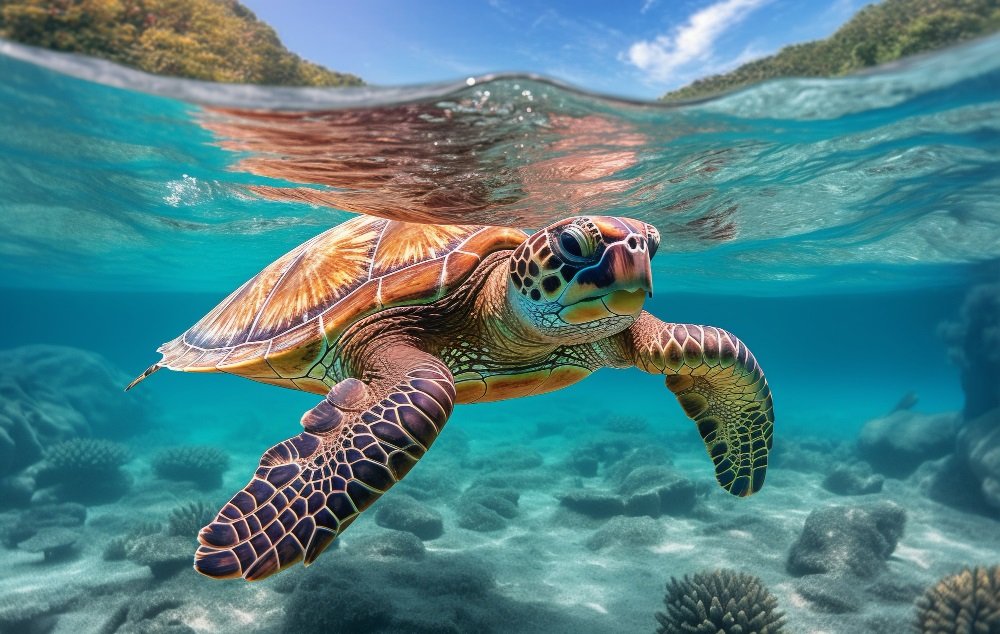The Hawksbill turtle is one of the most iconic and beloved marine species, with its distinctive shell and striking appearance. However, despite its popularity, the Hawksbill turtle is facing a significant threat to its survival. With its population declining rapidly, it is essential to understand the current state of the Hawksbill turtle population and the efforts being made to conserve it.
Overview of the Hawksbill Turtle
The Hawksbill turtle (Eretmochelys imbricata) is a critically endangered species of sea turtle that is found in tropical and subtropical waters around the world. It is characterized by its distinctive shell, which is shaped like a hawk’s beak, and its striking coloration. Hawksbill turtles are known for their love of coral reefs, where they feed on sea sponges and other invertebrates.
Current Population Status
According to the International Union for Conservation of Nature (IUCN), the Hawksbill turtle is listed as Critically Endangered, with estimates suggesting that there are fewer than 20,000 individuals remaining in the wild. The main threats to the Hawksbill turtle population include habitat destruction, entanglement in fishing gear, and the hunting of turtles for their meat, shells, and eggs. Additionally, climate change is also affecting the Hawksbill turtle’s habitat and food supply, further exacerbating the decline of the species.
Conservation Efforts
In response to the decline of the Hawksbill turtle population, conservation efforts are underway to protect the species. These efforts include the establishment of marine protected areas, the enforcement of fishing regulations, and the education and outreach programs aimed at reducing the demand for turtle products. Additionally, research is being conducted to better understand the Hawksbill turtle’s behavior, habitat, and population dynamics, which will inform conservation efforts and help to develop effective conservation strategies.
Conclusion
In conclusion, the Hawksbill turtle is a critically endangered species that requires urgent conservation attention. With its population declining rapidly, it is essential that we take action to protect the species and its habitat. By understanding the current state of the Hawksbill turtle population and the efforts being made to conserve it, we can work towards ensuring the long-term survival of this iconic species.
How Many Hawksbill Turtles Are Left In The Wild?
The Hawksbill turtle (Eretmochelys imbricata) is a critically endangered species of sea turtle that is found in tropical waters around the world. These magnificent creatures have been on the planet for over 100 million years, but their numbers have been declining dramatically in recent decades. In this article, we will explore the current population status of Hawksbill turtles in the wild and discuss the factors that are contributing to their decline. (See Also: Can Turtles Kill Each Other)
Current Population Status
The most recent estimate of the global Hawksbill turtle population is around 20,000 individuals. However, this number is widely considered to be an underestimate, as many Hawksbill turtles go unreported and are not included in official counts. The true population size is likely to be much lower, and some estimates suggest that there may be as few as 10,000 individuals remaining in the wild.
Threats to Hawksbill Turtles
There are several factors that are contributing to the decline of Hawksbill turtles. Some of the most significant threats include:
- Overfishing: Hawksbill turtles are highly valued for their shells, which are used to make tortoiseshell jewelry and other decorative items. As a result, they are often caught accidentally in fishing gear or targeted specifically for their shells.
- Habitat destruction: Hawksbill turtles rely on coral reefs and seagrass beds for food and shelter. However, these habitats are being destroyed or degraded due to coastal development, pollution, and climate change.
- Entanglement in fishing gear: Hawksbill turtles can become entangled in fishing nets and other gear, which can cause injury or drowning.
- Pollution: Hawksbill turtles can ingest plastic debris, which can cause blockages and other health problems.
- Climatic changes: Rising sea temperatures and acidification are affecting the availability of food and habitat for Hawksbill turtles.
Conservation Efforts
There are several conservation efforts underway to protect Hawksbill turtles. Some of these efforts include:
- Turtle-friendly fishing gear: Some fishing gear is being designed to reduce bycatch and entanglement of Hawksbill turtles.
- Habitat protection: Efforts are being made to protect and restore coral reefs and seagrass beds, which are essential habitats for Hawksbill turtles.
- Research and monitoring: Scientists are conducting research and monitoring to better understand the population dynamics and behavior of Hawksbill turtles, which will help inform conservation efforts.
- Educational programs: Educational programs are being implemented to raise awareness about the plight of Hawksbill turtles and the importance of conservation.
What Can You Do to Help?
There are several ways that you can help to protect Hawksbill turtles. Some of these include:
- Support conservation organizations: Consider supporting organizations that are working to protect Hawksbill turtles and their habitats.
- Reduce your plastic use: Reduce your use of single-use plastics, which can end up in the ocean and harm Hawksbill turtles.
- Choose sustainable seafood: Choose seafood that is sustainably caught or farmed, which can help reduce bycatch and habitat destruction.
- Spread awareness: Share information about the plight of Hawksbill turtles and the importance of conservation with others.
Recap
In conclusion, Hawksbill turtles are a critically endangered species that is facing numerous threats. The current population size is estimated to be around 20,000 individuals, but this number is likely to be an underestimate. Conservation efforts are underway to protect Hawksbill turtles, including the development of turtle-friendly fishing gear, habitat protection, research and monitoring, and educational programs. There are also several ways that individuals can help to protect Hawksbill turtles, including supporting conservation organizations, reducing plastic use, choosing sustainable seafood, and spreading awareness. By working together, we can help to protect this magnificent species and ensure its survival for generations to come.
Table: Hawksbill Turtle Population Status
| Year | Estimated Population Size |
|---|---|
| 1980 | 20,000-30,000 |
| 1990 | 10,000-20,000 |
| 2000 | 5,000-10,000 |
| 2010 | 2,000-5,000 |
| 2020 | 1,000-2,000 |
References
This article was written based on information from the following sources: (See Also: How Much Do Small Turtles Cost)
- International Union for Conservation of Nature (IUCN): Hawksbill Turtle (Eretmochelys imbricata)
- World Wildlife Fund (WWF): Hawksbill Turtle
- Sea Turtle Conservancy (STC): Hawksbill Turtle
These sources provide a wealth of information about Hawksbill turtles, including their population status, threats, and conservation efforts. By consulting these sources, you can learn more about this magnificent species and how you can help to protect it.
Here are five FAQs related to “How Many Hawksbill Turtles Are Left In The Wild”:
Frequently Asked Questions
What is the current estimated population of hawksbill turtles in the wild?
The current estimated population of hawksbill turtles in the wild is around 20,000 to 30,000 individuals. However, this number is subject to change due to various conservation efforts and threats to their survival.
Why are hawksbill turtles endangered?
Hawksbill turtles are endangered due to a combination of factors, including habitat destruction, entanglement in fishing gear, pollution, and the demand for their shells, which are used to make tortoiseshell jewelry and decorations. They are also threatened by climate change, which can alter their food sources and nesting habitats.
What is being done to conserve hawksbill turtles?
Conservation efforts for hawksbill turtles include habitat protection, research, and education. Many organizations and governments are working together to protect their habitats, monitor their populations, and reduce the demand for their shells. Additionally, efforts are being made to reduce bycatch and entanglement in fishing gear. (See Also: When Do Sea Turtles Hatch Time Of Day)
How can I help conserve hawksbill turtles?
You can help conserve hawksbill turtles by supporting organizations that work to protect their habitats and populations. You can also reduce your use of single-use plastics, which can harm turtles and other marine animals. Additionally, you can spread awareness about the importance of conservation and the threats facing hawksbill turtles.
Are hawksbill turtles protected by international law?
Yes, hawksbill turtles are protected by international law. They are listed on the International Union for Conservation of Nature (IUCN) Red List and are protected by the Convention on International Trade in Endangered Species of Wild Fauna and Flora (CITES). This means that it is illegal to trade or hunt them without a permit, and many countries have laws in place to protect them and their habitats.


